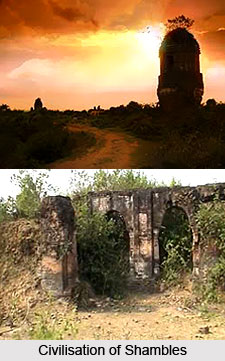 History of Purulia district is recorded from the time when the British East India Company attained the "grant of Diwani" of Bengal, Bihar and Orissa in the year 1765. But the archaeological surveys and the relics and the inscriptions, which have been deciphered till date, signifies the verity that Purulia existed to be a significant part of the territory of Sixteen Mahajanapadas. Following the Jaina Bhagavati-Sutra, Purulia district existed even in the circa 5th century A.D. The ancient history of Purulia was depicted with the name Vajra- bhumi. Vajra-bhumi (present Purulia), in the medieval times includes the whole part of present Jharkhand.
History of Purulia district is recorded from the time when the British East India Company attained the "grant of Diwani" of Bengal, Bihar and Orissa in the year 1765. But the archaeological surveys and the relics and the inscriptions, which have been deciphered till date, signifies the verity that Purulia existed to be a significant part of the territory of Sixteen Mahajanapadas. Following the Jaina Bhagavati-Sutra, Purulia district existed even in the circa 5th century A.D. The ancient history of Purulia was depicted with the name Vajra- bhumi. Vajra-bhumi (present Purulia), in the medieval times includes the whole part of present Jharkhand.
However Vajra -bhumi, since its advent has passed through several hands, has underwent massive change and the whole district continued to exist as a fragmented sections controlled by several kings. Hence the authentic account of the ancient history of Purulia is not available. Finally the entire territory of Bengal came under the Muslim sway in 1365, when the Afghan Chief Bakhtiyar Khalji ousted the last Sena king Lakshman Sena from Bengal. Bengal reached its culmination in the Sultanate regime, who consolidated the disintegrated portions of Bengal and established a separate territory. Following the ancient chronicle accounts of Purulia it was under these Subha or the Sultans, the broken fragments of Purulia and other parts of Bengal were united.
In the year 1765, demolishing the last sovereign king of Bengal, Siraj-ud-daulah in the Battle Of Plassey, the British take over the sovereignty of Bengal. The history of Purulia begins with the suzerainty of the British in the entire tract of Bengal. The British finally attained the grant of Diwani of Bengal, Bihar and Orissa. In 1805, by Regulation of XVIIII, the British formed a new district called "Jungle Mahals", incorporating 23 Parganas and Mahals, including the present Purulia. In 1833 jungle Mahals was again disintegrated and was constituted a new district,"Manbhum", with it`s headquarter at Manbazar. Manbhum was a vast district including the areas of Bardhaman, Bankura and Dhanbad, Dhalaibhum, Saraikela and Kharswan of present Jharkhand.
As the history of Purulia District depicts in 1838, the district headquarter was shifted to present Purulia for administrative convenience. Since Purulia District has been recognized as the district headquarters of Jungle Mahals, it was withdrawn from the direct administration and placed under the intervention of the delegates of the British Raj. An officer called Principal assistant to the agent of the Governor General to the South West Frontier ruled Purulia district. The abrupt alteration and the rapid changes continue to illustrate the history of Purulia even after independence and partition of Bengal. Finally with the act of Transfer of Territories in 1956, the district of Manbhum was separated between Bihar and West Bengal and the present district of Purulia is born out of that separated tract of Manbhum on 1st November 1956.



















